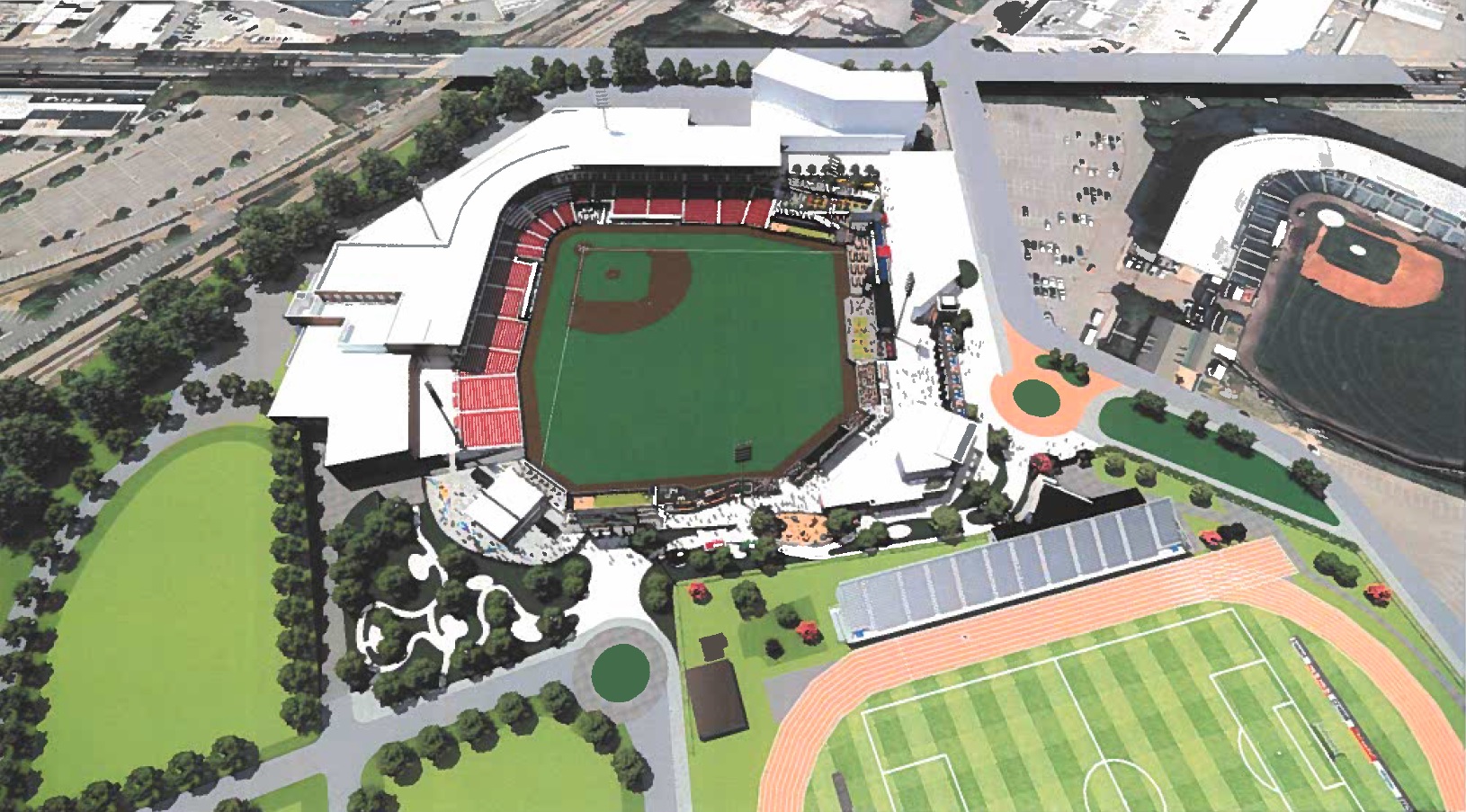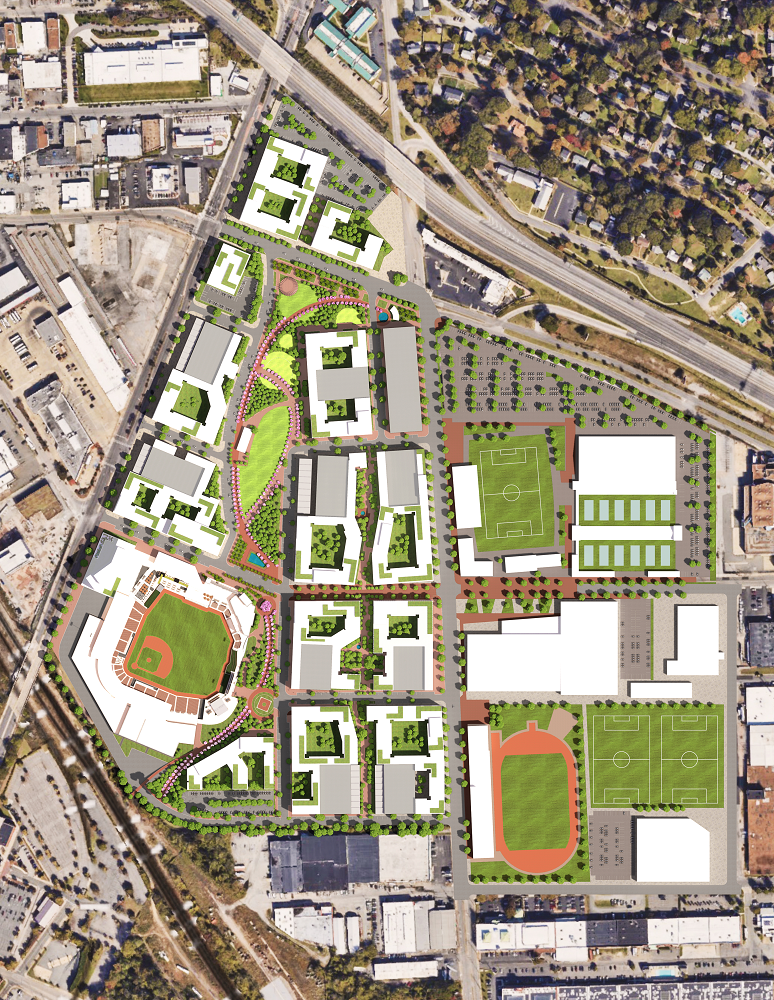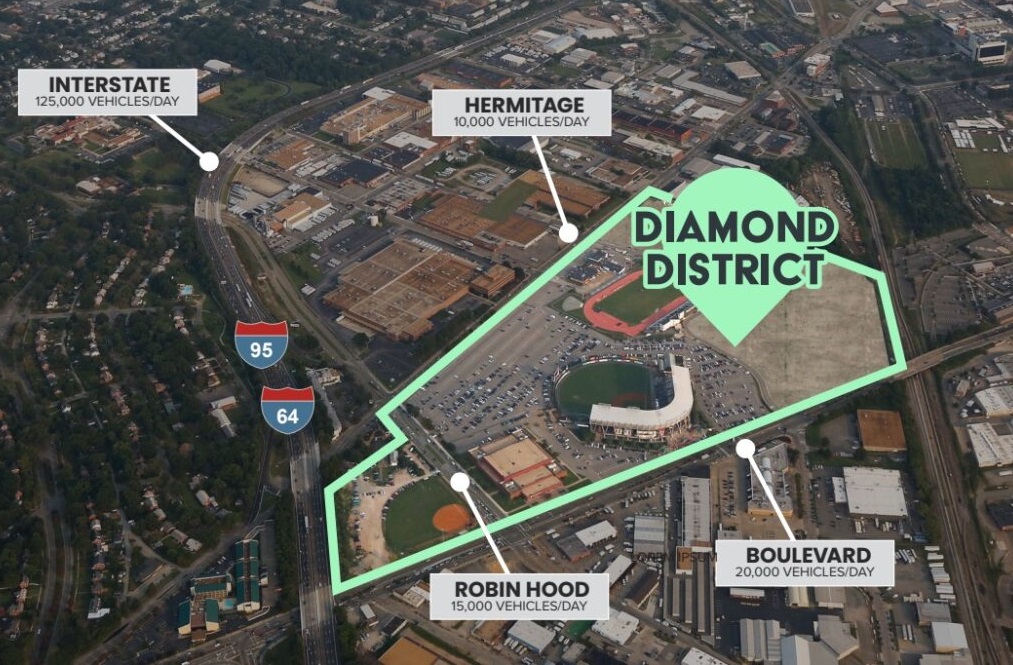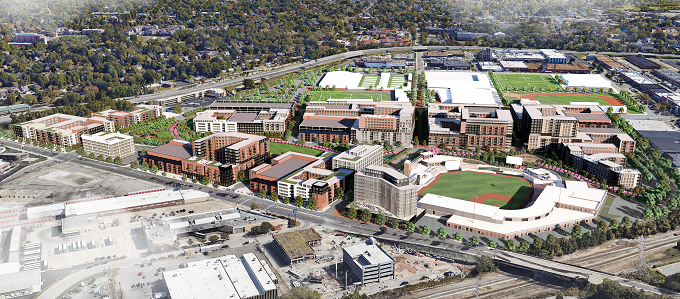More details are coming to light about how Richmond’s new plan to finance the ballpark-anchored Diamond District development would play out.
Ordinances introduced Monday by City Council reveal more of the nitty-gritty behind the new plan in which the city would issue its own bonds to finance the ballpark and infrastructure for the development’s first phase, which has grown in size and scope.
Where the first phase had previously totaled 22 acres, with the ballpark filling a 7-acre footprint, a new development plan included in the ordinances shows the first phase now totaling 30 acres, with the 360-degree-design, 10,000-seat stadium filling 10 of those acres.
The first phase now includes land north of Robin Hood Road as well as areas adjacent to the stadium at the site’s southern end. The new agreement calls for those sites to be developed in three subphases, the first of which includes the ballpark and land beside it.
The city would issue $170 million in bonds to finance the total phase, with $130 million in general obligation bonds going to the ballpark and $40 million in lease revenue bonds covering the infrastructure improvements.
The stadium bonds would cover construction of the $110 million stadium as well as costs to design, acquire and equip it.
The city would assume the debt on all of those bonds, meaning it would be responsible for repaying them if the stadium isn’t built or the project does not pay for itself with tax revenue generated by the development over time.
The city wants to issue its own bonds because of the cost savings expected from a lower municipal interest rate and to secure $24 million in state sales tax incentives that are set to expire July 1. Issuing its own bonds also would ensure a faster turnaround to complete the ballpark by the city’s April 2026 target.
Debt depends on ballclub lease

The new ballpark would rise just south of The Diamond, between Sports Backers Stadium and the railroad crossing along Arthur Ashe Boulevard.
The debt on the stadium bonds would amount to $7 million in annual payments that otherwise would be covered by the incremental tax revenue. The infrastructure debt payments would be $3 million annually, depending on the amount of stadium rent to be paid by the Richmond Flying Squirrels that otherwise would cover the cost of the bonds.
The ballclub’s lease agreement would establish the rent payments but has yet to be finalized and was not included in the ordinances, which council could vote on after a public hearing scheduled for its April 22 meeting.
Also referred to in but missing from the documents is a development agreement for the new ballpark between the Navigators Baseball LP, which is the Flying Squirrels’ ownership entity, and the Richmond Economic Development Authority, which owns the land.
A recent arrangement has allowed the ballclub to take the lead on design and development of the stadium specifically, working with consultant Machete Group and architect Odell, while the rest of the 67-acre mixed-use development is to be managed by the city’s selected development team.
An amended development agreement with that team, now called Diamond District Partners, is included among the ordinances. The new entity is led by Thalhimer Realty Partners and Loop Capital and does not include Republic Properties, which had led a previous iteration RVA Diamond Partners.
The new development agreement is meant to reflect those and other changes to the project’s first phase, though an attachment listing the team’s key personnel is not included in the version introduced Monday. Republic’s status with the project was questioned by Councilmember Ann-Frances Lambert in Monday’s meeting.
The Flying Squirrels’ lease needs to be signed before the initial land in the phase can be sold to Diamond District Partners. The team is aiming to break ground on its part of the development in July, while site work for the stadium is targeted to start in June.
Land purchase prices changed

A bird’s eye view of the envisoned Diamond District development and VCU Athletic Center across Hermitage Road.
Under the new agreement, Diamond District Partners would potentially pay $25 million for the 20 acres that make up its part of the first phase.
The group is committed, however, to purchase only the first subphase – about a dozen acres, for which it would pay $11.4 million. It would have options to buy the rest of the land in the first phase: $5.7 million for 5.7 acres, and $7.9 million for 2.3 acres that includes the existing Sports Backers Stadium, which will be demolished.
The agreement gives the group first right of refusal on any offer the city might receive on other land in the project site, with the city agreeing to sell that land to the group at the offer received.
Previously, when the development team was responsible for all of the first phase, which totaled 22 acres including the 7-acre stadium, it had agreed to pay $16 million for the land and to buy $20 million in bonds to support the stadium development. It would no longer need to buy bonds under the new plan.
Where the first phase previously planned to consist of more than 1,100 residential units, 58,000 square feet of retail, a 180-room hotel and an 11-acre public park, the larger first phase allows for more development within it but staggers the delivery. The park also has been dropped in size to 7 acres.
The first subphase is to include the hotel, nearly 900 housing units with about 160 units for lower-income residents, 20,000 square feet of commercial space, infrastructure and park space.
Phase 1B, which includes part of the current Diamond property, is planned for 335 housing units, 124 of them for lower-income residents and 10 for-sale units, 12,400 square feet of commercial space, infrastructure and park space. That subphase would also involve the demolition of Sports Backers Stadium and The Diamond.
Phase 1C involves 467 housing units with 54 of them for lower-income residents and 14 for sale, over 100,000 square feet of commercial space, and infrastructure and park space.
Minimum capital investment in the first phase overall would total over $567 million, compared to $627 million in the previous plan that included the stadium costs. Diamond District Partners would be committed to $300 million for Phase 1A, while Phase 1B would be $133.8 million and 1C would be $132.7 million.
Previously approved community benefits remain unchanged, with the overall Diamond District project still requiring minority business participation and a mix of housing styles and price and rental ranges.
The new development agreement states that Diamond District Partners “shall enter into a cooperation agreement” with the ballclub by May 28 to establish agreements between them regarding the stadium project and any infrastructure required to accommodate it.
CDA still planned

The 60-plus acres are bordered by Arthur Ashe Boulevard, Hermitage Road, the interstate and the railroad tracks.
In addition to the new development agreement and the $170 million bond issuance, the ordinances also would approve the city’s financing plan for the first-phase infrastructure improvements and would establish the community development authority, or CDA, that had been planned to be the financing mechanism for the project all along.
While the city is issuing its own bonds for the first phase, the CDA would still be an option to issue bonds for the rest of the $2.4 billion development, which is expected to take 15 years to complete.
The CDA district would be returned to within the boundaries of the 67-acre Diamond District site, freeing up additional adjacent properties that had been tacked onto the district through an expansion last year. Those properties would continue to generate taxes for general city services as a result.
Council would appoint the CDA’s five members at the same time it adopts the ordinance creating it. Candidates for the posts are to be recommended to council over the next few weeks, leading up to a separate public hearing to be held in a special meeting May 8.
The CDA would be authorized to issue bonds for infrastructure improvements and impose fees for services in the district, such as a surcharge on guest stays at hotels in the development and a consumer use surcharge on purchases within the district.
City Council’s Finance and Economic Development Standing Committee is scheduled to review the ordinances at its April 18 meeting, with the council public hearing to follow April 22 and the CDA special meeting and hearing May 8.
More details are coming to light about how Richmond’s new plan to finance the ballpark-anchored Diamond District development would play out.
Ordinances introduced Monday by City Council reveal more of the nitty-gritty behind the new plan in which the city would issue its own bonds to finance the ballpark and infrastructure for the development’s first phase, which has grown in size and scope.
Where the first phase had previously totaled 22 acres, with the ballpark filling a 7-acre footprint, a new development plan included in the ordinances shows the first phase now totaling 30 acres, with the 360-degree-design, 10,000-seat stadium filling 10 of those acres.
The first phase now includes land north of Robin Hood Road as well as areas adjacent to the stadium at the site’s southern end. The new agreement calls for those sites to be developed in three subphases, the first of which includes the ballpark and land beside it.
The city would issue $170 million in bonds to finance the total phase, with $130 million in general obligation bonds going to the ballpark and $40 million in lease revenue bonds covering the infrastructure improvements.
The stadium bonds would cover construction of the $110 million stadium as well as costs to design, acquire and equip it.
The city would assume the debt on all of those bonds, meaning it would be responsible for repaying them if the stadium isn’t built or the project does not pay for itself with tax revenue generated by the development over time.
The city wants to issue its own bonds because of the cost savings expected from a lower municipal interest rate and to secure $24 million in state sales tax incentives that are set to expire July 1. Issuing its own bonds also would ensure a faster turnaround to complete the ballpark by the city’s April 2026 target.
Debt depends on ballclub lease

The new ballpark would rise just south of The Diamond, between Sports Backers Stadium and the railroad crossing along Arthur Ashe Boulevard.
The debt on the stadium bonds would amount to $7 million in annual payments that otherwise would be covered by the incremental tax revenue. The infrastructure debt payments would be $3 million annually, depending on the amount of stadium rent to be paid by the Richmond Flying Squirrels that otherwise would cover the cost of the bonds.
The ballclub’s lease agreement would establish the rent payments but has yet to be finalized and was not included in the ordinances, which council could vote on after a public hearing scheduled for its April 22 meeting.
Also referred to in but missing from the documents is a development agreement for the new ballpark between the Navigators Baseball LP, which is the Flying Squirrels’ ownership entity, and the Richmond Economic Development Authority, which owns the land.
A recent arrangement has allowed the ballclub to take the lead on design and development of the stadium specifically, working with consultant Machete Group and architect Odell, while the rest of the 67-acre mixed-use development is to be managed by the city’s selected development team.
An amended development agreement with that team, now called Diamond District Partners, is included among the ordinances. The new entity is led by Thalhimer Realty Partners and Loop Capital and does not include Republic Properties, which had led a previous iteration RVA Diamond Partners.
The new development agreement is meant to reflect those and other changes to the project’s first phase, though an attachment listing the team’s key personnel is not included in the version introduced Monday. Republic’s status with the project was questioned by Councilmember Ann-Frances Lambert in Monday’s meeting.
The Flying Squirrels’ lease needs to be signed before the initial land in the phase can be sold to Diamond District Partners. The team is aiming to break ground on its part of the development in July, while site work for the stadium is targeted to start in June.
Land purchase prices changed

A bird’s eye view of the envisoned Diamond District development and VCU Athletic Center across Hermitage Road.
Under the new agreement, Diamond District Partners would potentially pay $25 million for the 20 acres that make up its part of the first phase.
The group is committed, however, to purchase only the first subphase – about a dozen acres, for which it would pay $11.4 million. It would have options to buy the rest of the land in the first phase: $5.7 million for 5.7 acres, and $7.9 million for 2.3 acres that includes the existing Sports Backers Stadium, which will be demolished.
The agreement gives the group first right of refusal on any offer the city might receive on other land in the project site, with the city agreeing to sell that land to the group at the offer received.
Previously, when the development team was responsible for all of the first phase, which totaled 22 acres including the 7-acre stadium, it had agreed to pay $16 million for the land and to buy $20 million in bonds to support the stadium development. It would no longer need to buy bonds under the new plan.
Where the first phase previously planned to consist of more than 1,100 residential units, 58,000 square feet of retail, a 180-room hotel and an 11-acre public park, the larger first phase allows for more development within it but staggers the delivery. The park also has been dropped in size to 7 acres.
The first subphase is to include the hotel, nearly 900 housing units with about 160 units for lower-income residents, 20,000 square feet of commercial space, infrastructure and park space.
Phase 1B, which includes part of the current Diamond property, is planned for 335 housing units, 124 of them for lower-income residents and 10 for-sale units, 12,400 square feet of commercial space, infrastructure and park space. That subphase would also involve the demolition of Sports Backers Stadium and The Diamond.
Phase 1C involves 467 housing units with 54 of them for lower-income residents and 14 for sale, over 100,000 square feet of commercial space, and infrastructure and park space.
Minimum capital investment in the first phase overall would total over $567 million, compared to $627 million in the previous plan that included the stadium costs. Diamond District Partners would be committed to $300 million for Phase 1A, while Phase 1B would be $133.8 million and 1C would be $132.7 million.
Previously approved community benefits remain unchanged, with the overall Diamond District project still requiring minority business participation and a mix of housing styles and price and rental ranges.
The new development agreement states that Diamond District Partners “shall enter into a cooperation agreement” with the ballclub by May 28 to establish agreements between them regarding the stadium project and any infrastructure required to accommodate it.
CDA still planned

The 60-plus acres are bordered by Arthur Ashe Boulevard, Hermitage Road, the interstate and the railroad tracks.
In addition to the new development agreement and the $170 million bond issuance, the ordinances also would approve the city’s financing plan for the first-phase infrastructure improvements and would establish the community development authority, or CDA, that had been planned to be the financing mechanism for the project all along.
While the city is issuing its own bonds for the first phase, the CDA would still be an option to issue bonds for the rest of the $2.4 billion development, which is expected to take 15 years to complete.
The CDA district would be returned to within the boundaries of the 67-acre Diamond District site, freeing up additional adjacent properties that had been tacked onto the district through an expansion last year. Those properties would continue to generate taxes for general city services as a result.
Council would appoint the CDA’s five members at the same time it adopts the ordinance creating it. Candidates for the posts are to be recommended to council over the next few weeks, leading up to a separate public hearing to be held in a special meeting May 8.
The CDA would be authorized to issue bonds for infrastructure improvements and impose fees for services in the district, such as a surcharge on guest stays at hotels in the development and a consumer use surcharge on purchases within the district.
City Council’s Finance and Economic Development Standing Committee is scheduled to review the ordinances at its April 18 meeting, with the council public hearing to follow April 22 and the CDA special meeting and hearing May 8.

Great summary. Thanks, Jonathan.
100% agreed, Rick. Jonathan has done some amazing in-depth reporting on several major issues over the past year.
Jonathan, well done, sir!
It is an awesome summary and it keeps getting better and better for taxpayers….No agreement on lease amount, lease will ONLY pay the infrastructure bonds, the developer is not required to buy any of the bonds, and has been given the ability to back out of the full development of the area, it breaks the phase 1 into subphases which means those area will take LONGER to be developed and improved so it will be slower in generating new tax revenue. The developer is ONLY committed to do phase IA. And finally the City will issue $170M in direct obligated… Read more »
I’m shocked…. shocked…
On the upside, the sub parcels can be sold to the highest bidder if Thalhimer fails to execute. The land prices in Scotts Addition are now anywhere from $4-5 M per acre so that leaves some room for the City to sell its way out of its obligations. The cost of the ballpark has been and continues to be the albatross in the deal, occupying valuable land and offering little in financial return. The City Council wants the team in Richmond so there we are. We’ll have a $120M ballpark and entertainment venue.
Very well said, Bruce. While there are admittedly any number of economic drivers at play that have significantly boosted the cost of the ballpark, I’m just gobsmacked that the price tag of this facility, lovely though it might be, has ballooned roughly 70% over the course of the past 12 to 16 months. Was not the original cost of the stadium estimated to be at $70 million? And now we’re looking at $110 million to $120 million? Mind you, I’ve been a supporter of this development from the get-go, and I 100% want this entire redevelopment to come to pass… Read more »
Well, as the famous economist once said, if the facts change, may opinions should change?
Good points, Michael. All of this also makes me very concerned about the viability/feasibility of the City Center redevelopment downtown. Exactly HOW is the city going to try to launch City Center at (more-or-less) the same time that it’s slogging though the process of the Diamond District redevelopment? Without more private investment as opposed to public funds, I’m becoming increasingly skeptical we will see City Center ANY time this decade, if at all, just based on how the Diamond District seems to be panning out. What’s more – I’m not sure we’re a large enough market at this point to… Read more »
Good point. One of the things I was thumping the tub about long ago was that I couldn’t understand why they were doing what seemed like the least good deal for the city. But now a big part of my “Harping” is this issue of politicians letting the what they see as The Perfect being the enemy of The Good. When you can’t have it all, it makes sense to be flexible in a way that won’t hurt the people you are representing.
As usual the city has pushed this deal back to the point they will likely no be able to meet the requirement of the new stadium (the anchor of the whole development) completed and opened before the date set by MLB and the Squirrels. Sounds almost reminiscent of every other failed deal by the city over the past decades. Let’s hope they do no blow this deal up. This is a chance to revitalize a forgotten industrial area to recreate the city into a modern inclusive destination.
A 61 years old, I have seen the movie repeat over and over and over. I’m praying that this is not yet another sequel. This is yet another reason that the city has NO business trying to play land developer.
Remember Mayor Koch and the skating rink in Manhattan????
Should have worked a deal with the Atlanta Braves .We would have Triple A and be sitting in a fairly new Statium now .What was that 20 yrs. ago? Oh,well, it is what it is
But, sadly I see the minors pulling the plug on Richmond.
In 2023 the gwinett braves, a triple A team, drew 231,000 fans. Meanwhile, the squirrels, a double A team drew 428,000 which was the highest of all 2A teams, and higher than half of all 3A teams. Yet, you see the minors pulling the plug on Richmond? Please explain.
I don’t know Stephen,sorry I don’t have any facts or numbers why I believe there won’t be baseball in Richmond in 2026.Im just looking at the project in a common sense way.I don’t see progress,no dump trucks the heavy machinery,no cranes setting steel,nothing.Isnt that bridge over the train tracks due to be replaced?How about utilities, haven’t heard anything.All I see is some renderings that change weekly.Hell, who’s paying for the place.
My opinion should be the league won’t have to pull the plug,it just won’t be a new statium.
Explain why I should believe.
I think the city finally realized there can be no “free ” stadium and is pursuing a more realistic financial approach now. Meanwhile, I note that I see no movement on the new arena in Henrico. Perhaps the county will come to the same realization regarding that project as well. Unlike the ballpark it has no tenants and no certain income stream.
City leadership’s backs are against the wall now.No more free passes (due date changes)from the minors.
Nor should there be.
Yes they should have worked out a deal with the R braves. The Braves didnt want to leave and other than possibly the Yankees triple A team (columbus ) the Brave were the cream of the crop for triple A. They hung around 10 years longer than they wanted to waiting for the city to come to it’s senses. But alas you are dealing with the horribly inept Richmond City Council.
The Giants and MLB should tell the city to take a hike